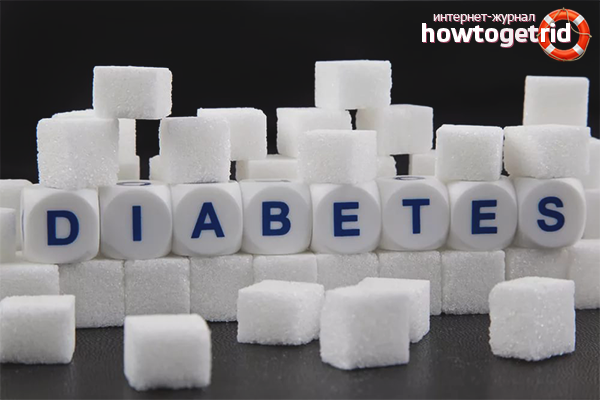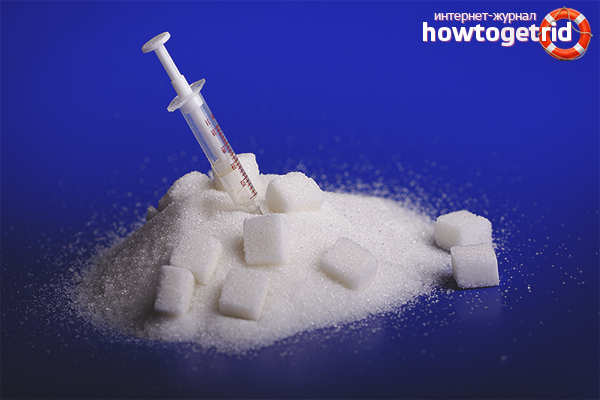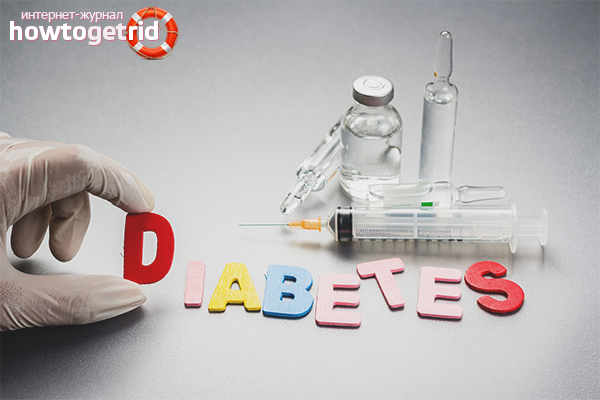The content of the article
Doctors of the whole world are puzzled by the problems of diabetes. Every year the disease becomes younger, more and more people are exposed to it. But do not despair if you suspect that you have diabetes. Modern technologies, medicines and methods of treatment allow you to take the disease under control. It has been universally proven that with the observance of treatment, diet and the doctor’s instructions, one can live with the disease.
Diabetes
What is this disease? To begin with, diabetes is an endocrine disease. The pancreas normally produces a certain amount of the hormone insulin, which the body needs to process simple carbohydrates. If this insulin is absent or catastrophically small, the body is not able to process sugar, the glucose level after eating jumps up. It can be very dangerous. So there is diabetes mellitus of the first type - insulin-dependent. This disease is more often diagnosed in young people. As a rule, they are thin even though they eat a lot. To treat such diabetes, patients are injected with insulin, which they lack so much.
The second type of diabetes is non-insulin dependent. In this case, the body produces a sufficient amount of insulin, but the tissues are not sensitive to this insulin for various reasons. Such diabetics are most often very obese, their disease is diagnosed at a more mature age. For their treatment, drugs are used that reduce the resistance of cells to insulin.
Still diabetes can be gestational. It develops or is detected during pregnancy. Also, diabetes can be secondary, that is, when the pancreas stops producing insulin due to the underlying disease (pancreatitis, cystic fibrosis, etc.)
Often a person can live with diabetes and not be aware of it. Often, diabetes symptoms are associated with other diseases. In order to identify this disease in yourself, you need to listen to your body.
Diabetes Symptoms
This is the first and most important way to determine your diabetes at home. Using the symptoms listed below, you will learn how to recognize diabetes.
- One of the main symptoms is frequent urination and irresistible thirst. Often a person constantly drinks because he feels dehydrated. So it is - the body is dehydrated, because the liquid does not stay and is not absorbed. If at least for a while you leave a person without access to water, he feels very dry in his mouth, the itching of the skin intensifies.
- Pruritus is a frequent companion of patients with diabetes. The palms, crotch, feet, and stomach are affected. This symptom is manifested in 4 out of 5 patients with diabetes. It is noteworthy that the itch is not removed by various ointments and gels.
- You should suspect that you have diabetes if your body has various wounds, cracks, scratches and ulcers that do not heal for a long time.
- Due to endocrine disorders, the general condition of a person changes. He becomes lethargic, sleepy, lethargic. Loses interest in work, family, household affairs. A constant feeling of tiredness and weakness during the day is a serious reason for taking tests.
- With diabetes, metabolic processes are disturbed, so the condition of the hair is worsened. They become weak and thin, often fall out.
- Type 1 diabetes is characterized by constant hunger. A person can eat an unusual amount of food at a time.At the same time, it does not grow fat, but on the contrary, it can lose 10-15 kg in a few months due to the fact that the carbohydrates eaten are simply not absorbed (there is no insulin).
- In diabetes mellitus, the smell of acetone from the mouth, nausea, vomiting may appear, a veil appears in front of the eyes, dizziness appears.
- Often limbs suffer, especially the legs. There is swelling, heaviness, various wounds on the skin that do not heal for a long time.
- Often in patients with diabetes, a decreased body temperature occurs. This is due to a slowdown in all metabolic processes in the body.
- Patients with diabetes mellitus suffer not just frequent urination, but a huge amount of urine excreted (up to 10 liters per day). Children with this diagnosis suffer from bedwetting, even if there were no such problems before.
- Many people with diabetes suffer from low immunity. As a result - frequent illnesses, a long course of infectious diseases.
- Type 2 diabetes is characterized by overweight, as well as visual impairment. This is because high sugar destroys the retina.
- In men, diabetes can be a cause of impaired sexual function. Often, diabetes leads to impotence.
If you notice at least a few of these symptoms, you need to see a doctor as soon as possible to find out the true diagnosis.
Why diabetes occurs
It has been proven that diabetes, as well as a predisposition to this disease, is a genetic component. Diabetes cannot be infected - it's a fact. If one of the parents had diabetes - the risk of your disease is 30%. If both parents were sick - 60-70%.
At risk are overweight people. If you have a predisposition to the disease, you should carefully monitor the weight and avoid exceeding normal values.
Another provoking factor for the development of the disease are pancreatic diseases. Also, diabetes mellitus may appear after some viral diseases - rubella, chickenpox, flu and epidemic hepatitis. Diabetes often affects people aged.
There is a misconception that those who love and eat a lot of sweets suffer from diabetes. This is nothing more than a myth.
How to determine urine sugar
If you suspect you have diabetes, but still do not want to see a doctor, you can try to detect the level of sugar in your urine with the help of improvised means.
To determine the level of sugar in the urine, there are special strips that you can buy at the pharmacy. They are used by all diabetics. It is important to do the test in the morning on an empty stomach and after eating. The strip is covered with a special reagent, which, when it comes into contact with urine, changes color. The strip should be lowered into a jar of urine or just hold it under running. It is forbidden to touch the test strip with your hands or wipe with a towel. Usually the result can be obtained in a minute.
Depending on the color of the strip, the level of sugar in the urine is determined. However, such a check is not informative for type 1 diabetics, as well as for people older than 50 years. Often, test strips can only respond to a very large amount of sugar - more than 10 mmol per liter. This amount is called the renal threshold. If the test shows in the urine the amount of sugar is greater than this indicator, then glucose seeps into the urine and the body is unable to cope with it.
How to determine blood sugar
There are also strips that measure blood sugar. To get an analysis, you need to wash your hands thoroughly, since a small amount of sugar on the surface of the skin can lead to distortion of the results. A clean finger should be pierced with a sterile needle and lowered down so that a drop of blood appears. Attach a test strip to the drop so that the entire reagent area is covered in blood.After that, you need to wait a while until the color appears on the strip. Each color corresponds to a certain amount of sugar - this can be found on the packaging of test strips.
Everywhere they use glucometers, which also work with test strips. The strip is placed in a drop of blood, and then inserted into the device. It accurately determines blood sugar. Some modern models are equipped with a memory function, an audio signal, as well as the ability to memorize results.
Normally, sugar levels are between 3.3 and 6.1 mmol per liter if taken on an empty stomach. After eating, the amount of sugar can increase to 9 and 10 mmol per liter. Some time after eating (1-2 hours), sugar returns to normal again. If your indicators are significantly higher than normal - do not pull, immediately see a doctor!
Diabetes mellitus - what to do?
If you have been given this diagnosis, there is no need to panic. Proper treatment and maintenance of the necessary functions of the body will help you not to suffer from diabetes, but get along with it calmly. Here are the basic rules for a normal life with diabetes.
- Eliminate sugar intake - you need to take a sweetener instead. Less cholesterol, fractional nutrition, animal fats are replaced with vegetable fats. It is very important to follow a strict diet - no fast carbohydrates.
- You need to regularly monitor your blood sugar to control your body.
- If you are overweight, you need to lose extra pounds. Exercise regularly with moderate physical activity.
- Every day you need to carefully inspect the legs for damage to the skin. Before going to bed, you should wash your feet with soap and dry thoroughly with a towel. This is important because with diabetes there is a high risk of trophic ulcers on the legs.
- Visit your dentist in a timely manner to avoid tooth decay and exclude a foci of infection.
- Try to avoid stressful situations and nervous shocks.
- Take the medications your doctor has prescribed regularly. Carry insulin in your bag to take medicine in an emergency. In addition, you need to carry a note in your purse or pocket with a message about the presence of diabetes mellitus, as well as the address and phone number of the person who could arrive in case of an unforeseen situation.
- When wounds appear, you need to treat them, start intensive treatment immediately, even if it is a simple scratch.
- Once every six months, you need to be examined for any complications - first of all, you need to check your kidneys, liver, eyesight.
- Stop smoking and drinking alcohol.
- Sanatorium treatment should be carried out regularly to strengthen immunity.
Many diabetics admit that these simple rules are so firmly entrenched in their lives that they consider them mundane and natural. For them, measuring blood sugar levels is as simple and necessary as brushing your teeth or eating. Diabetes is not a sentence. If you are diagnosed with this diagnosis, you just need to learn how to live with it. And then the quality of your life will not change.
Video: diabetes symptoms












Submit